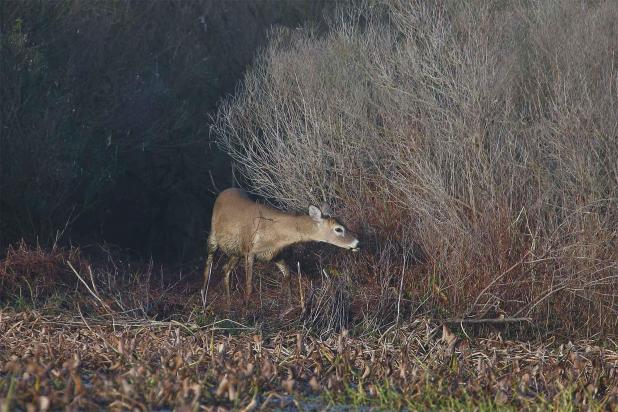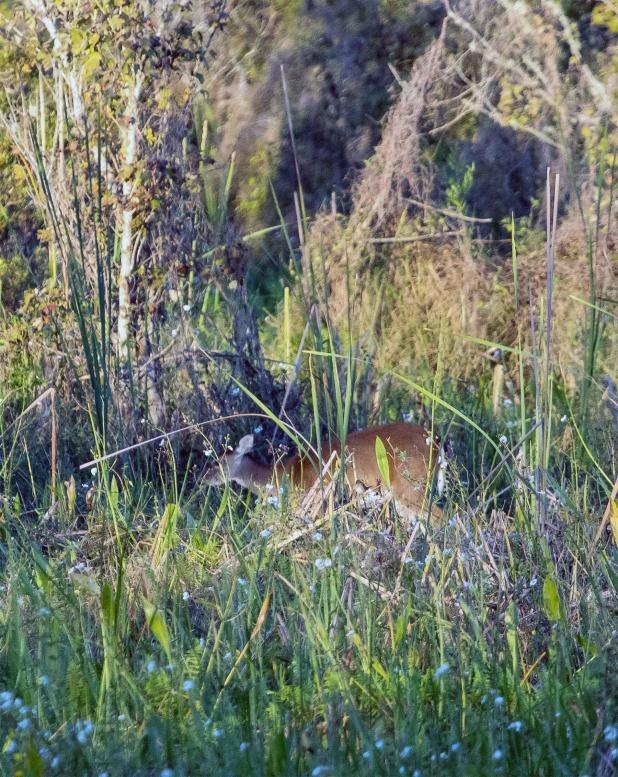
The Review/John Flores
This young spike buck walks the edge of the marsh looking for food.

The author saw this doe clinging to cover while hunting the second weekend in November.
John Flores: Plenty of hunting left in St. Mary deer habitat
Earlier this month, my good friend Jimmy Wilson invited me deer hunting on his lease south of Centerville, down La. 317 near Burns Point. Jimmy and I met some 37 years ago at a church function neither one of us seemed too thrilled about attending.
It’s funny how there can be a room full of people and if they’re only two guys in the whole place who like to hunt, they’ll find each before the event is over. In this case it was a picnic on Avoca Island.
At the time, I happened to have access to some hunting ground through my father-in-law, who trapped the marsh near Wax Lake. So, I invited him to come with me that fall.
Now I’m the guy not in a hunting lease and it’s the other way around. Jimmy has invited me the last couple of years to make a hunt with him.
A couple weeks prior to our hunt we had a conversation, where my friend said they really hadn’t been seeing a whole lot of deer. That struck me as strange for the time of year.
Essentially, Area 7 has what’s known as “divergent” rut, which means unlike other deer hunt areas in the state, the peak of the rut could run from the third week of October through the second week in November. What’s more, it’s during the rut when most bucks are killed.
Essentially, they throw caution to the wind and have one thing and one thing only on their mind as does come into estrus. The notion of not seeing any deer sort of threw me a curve and the first thoughts that came to my mind were maybe the deer numbers simply weren’t there. After all, when you go back to the summer and fall of 2020, the biggest thing that stood out was five storms impacted our coastline, which could possibly have had far reaching effects on whitetail populations.
Storm surge will often push deer to higher ground, which in most cases is levees and the few remaining oak Chaniers scattered across the coastline. When deer are able to return to the marsh, often times browse and other food sources are reduced to less than marginal levels.
What can typically happen when this occurs is not necessarily die offs of deer, but instead stress that leads to lower lactation rates. When there is a drop in the percentage of lactating does, it typically means a decline in recruitment, or number of yearling deer in subsequent years.
This year’s Louisiana Deer Report, which is a compilation of harvest data from July 1, 2020-June 30, 2021, suggested last year’s deer season was actually very good across the state despite the active storm season.
Some 171,800 hunters harvested 192,000 deer last year.
Louisiana Department of Wildlife and Fisheries Deer Program Manager Johnathan Bordelon, said, “The reported statewide harvest was the highest reported harvest for the past 10 seasons. While the reported harvest was the highest in 10 seasons, the percentage of bucks, 55%, and does, 45%, was on pace with previous seasons and was near the 10-year average.”
According to Bordelon, last season’s reported harvest in St. Mary Parish was 1,102 deer, which nearly matched the 1,092 10-year average for the parish. Of those 1,102 deer harvested in St. Mary last year, 60% were bucks compared to the 10-year average of 64%.
“The percentage of bucks and does has not fluctuated far from the average despite different allowances for either-sex deer over the past 10 years,” Bordelon said.
Essentially, St. Mary Parish’s coastal marsh has an abundance of food that deer like, such as cow peas, alligator weed (a.k.a. water vine), willow tree leaves, and other browse that rivals many of the northern parishes. Unfortunately, Bordelon says, it is difficult to compare St. Mary’s reported harvest to most of the state, because of the use of forested acres per deer harvested statistic, where coastal parishes have an extensive amount of marsh habitat that supports deer.
Bordelon said, “Rather than comparing St. Mary to the rest of the state, it may be noteworthy in mentioning that the reported harvest in St. Mary is double the reported harvest of any other coastal parish. The productivity of the marsh for deer is evident in the sustained harvest success in St. Mary.”
Oftentimes a week will make a huge difference. The weekend prior to Jimmy and my hunt he started seeing some deer. As it turned out, the deer hadn’t gone anywhere. For whatever reason be it weather-related, moon phase, or an anomaly in the timing of the rut, they started moving again.
What’s more, the weekend we hunted I did see some does feeding but didn’t shoot due to the distance and cover they clung to. Part of hunting is being sure of your shot, therefore, making a humane kill.
Jimmy saw five deer that morning and, like me, didn’t shoot either. On Sunday, he took a doe, while his grandson saw a four-point that didn’t offer him an opportunity.
Firearms season runs through Jan. 2 in St. Mary Parish. There is a full week of Primitive Firearm Season remaining Jan. 3-9 and Archery Season is open through Jan. 15.
